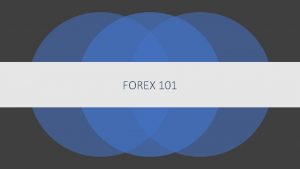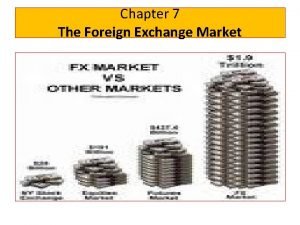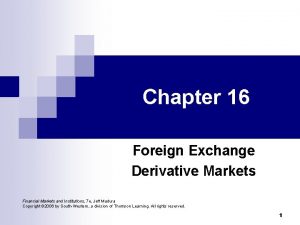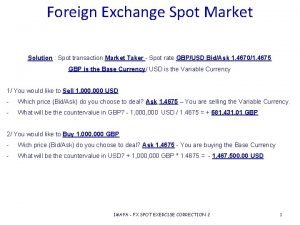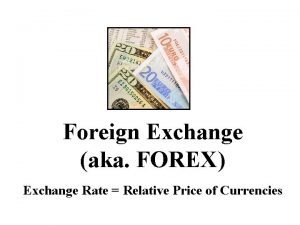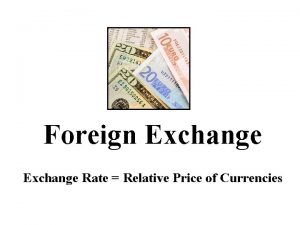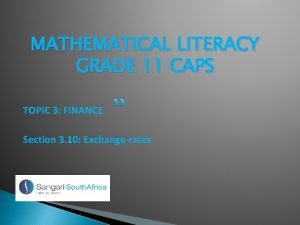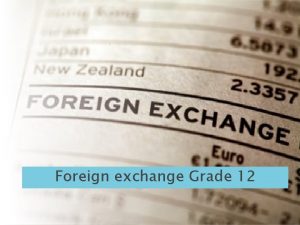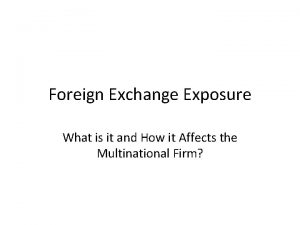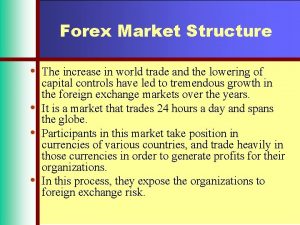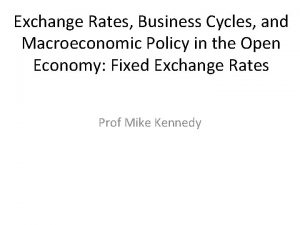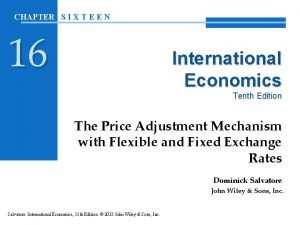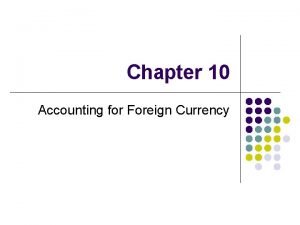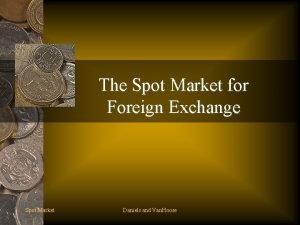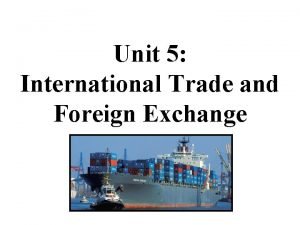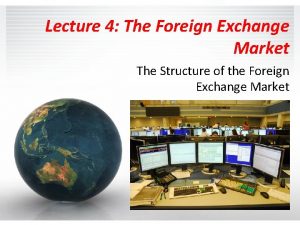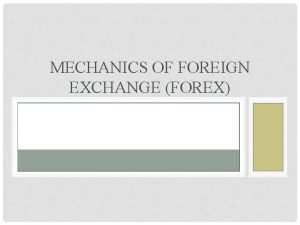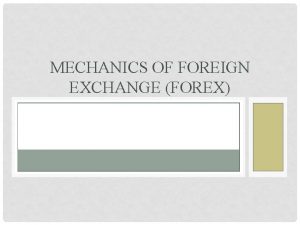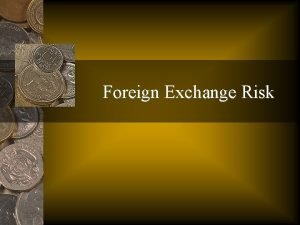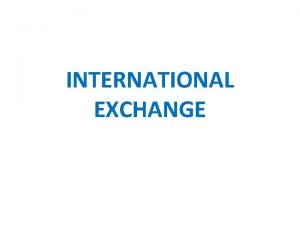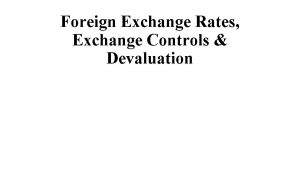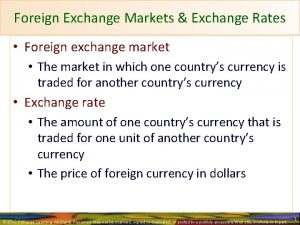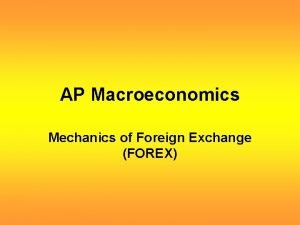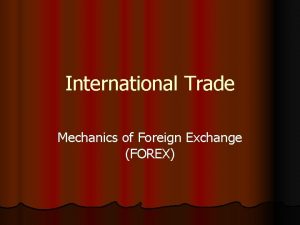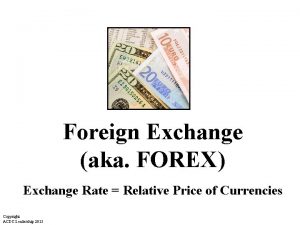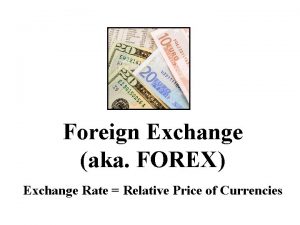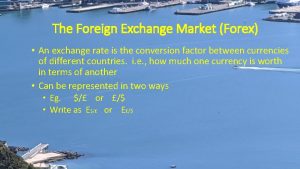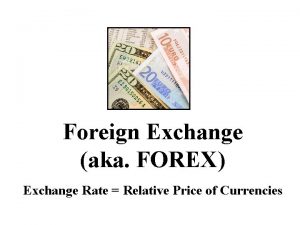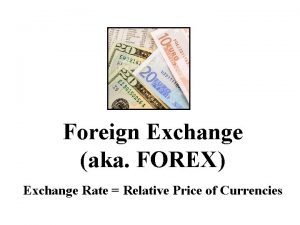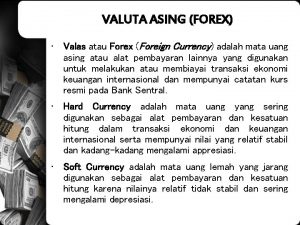FOREX 101 What is Forex Foreign Exchange Forex



















- Slides: 19

FOREX 101

What is Forex? • Foreign Exchange • Forex Market • FX • Currency Trading • A decentralized global market where all the world's currencies trade • Traders consist of banks, businesses, governments, investors and retail traders (like me) who speculate on currencies.

Introduction • Freddy Martinez • Systems Programmer @ ECISD • Forex Technical Analyst by night • Financial goal: Make money out of money

Trading hours? • The Fx market is open 24 hours a day, 5 days a week with the most important world trading centers being located in London, New York, Tokyo, Zurich, Frankfurt, Hong Kong, Singapore, Paris, and Sydney.

What is Forex? • Most liquid market with an average daily trading volume of +$5 Trillion • Not even all stock markets combined come close

Oversight? • There is no central marketplace • Trading is conducted ‘over the counter’ • It’s not like stocks where there is a central marketplace with all orders processed like the NYSE • Forex is a product quoted by all the major banks, and not all banks will have the exact same price

What is Forex Trading? • Forex trading is the speculation on the price of one currency against another. • For example, if you think the euro is going to rise against the U. S. dollar, you can buy the EURUSD currency pair low and then (hopefully) sell it at a higher price to make a profit. Of course, if you buy the euro against the dollar (EURUSD), and the U. S. dollar strengthens, you will then be in a losing position. • Or imagine exchanging $100 USD into pesos and then the peso's value increases. Exchanging back to USD will net you more than $100 because the peso was worth more than when you bought it.

Exchange Rate • The value of one currency expressed in terms of another. For example, if EUR/USD is 1. 3200, 1 Euro is worth US$1. 3200.

Pip • The smallest increment of price movement a currency can make. Also called point or points. For example, 1 pip for the EUR/USD = 0. 0001 and 1 pip for the USD/JPY = 0. 01.

Leverage • Leverage is the ability to gear your account into a position greater than your total account margin. For instance, if a trader has $1, 000 of margin in his account and he opens a $100, 000 position, he leverages his account by 100 times, or 100: 1. • If he opens a $200, 000 position with $1, 000 of margin in his account, his leverage is 200 times, or 200: 1. • Increasing your leverage magnifies both gains and losses.

Currency Pairs • The exchange rate of two currencies is quoted in a pair, such as the EURUSD or the USDJPY. • The reason for this is because in any foreign exchange transaction you are simultaneously buying one currency and selling another. I • f you were to buy the EURUSD and the euro strengthened against the dollar, you would then be in a profitable trade.

Bid and Ask Price • Bid Price – The bid is the price at which the market (or your broker) will buy a specific currency pair from you. Thus, at the bid price, a trader can sell the base currency to their broker. • Ask Price – The ask price is the price at which the market (or your broker) will sell a specific currency pair to you. Thus, at the ask price you can buy the base currency from your broker.

Two types of trades

Long • Buying • LONG – When we go long it means we are buying the market and so we want the market to rise so that we can then sell back our position at a higher price than we bought for. This means we are buying the first currency in the pair and selling the second. • So, if we buy the EURUSD and the euro strengthens relative to the U. S. dollar, we will make money!

Short • Selling • SHORT – When we go short it means we are selling the market and so we want the market to fall so that we can then buy back our position at a lower price than we sold it for. This means we are selling the first currency in the pair and buying the second. So, if we sell the GBPUSD and the British pound weakens relative to the U. S. dollar, we will be in a profitable trade.

Forex Fight: Bulls vs Bears

Bullish Chart

Bearish Chart

Technical Analysis • RSI • MACD • Stochastics • Volume • Moving Averages • Bollinger Bands • Multi-time frame analysis • Price Action • Divergence
 So here you are too foreign for home
So here you are too foreign for home Forex 101
Forex 101 Functions of foreign exchange market
Functions of foreign exchange market Salient features of foreign exchange management act 1999
Salient features of foreign exchange management act 1999 Foreign exchange derivative
Foreign exchange derivative Spot market exchange
Spot market exchange Worldwide international student exchange (wise)
Worldwide international student exchange (wise) 4 shifters of foreign exchange
4 shifters of foreign exchange Exchange market graph
Exchange market graph Exchange rate maths literacy grade 12
Exchange rate maths literacy grade 12 Tourism grade 12 foreign exchange
Tourism grade 12 foreign exchange Types of foreign exchange exposure
Types of foreign exchange exposure What is market structure in forex
What is market structure in forex Exchange rate graph economics
Exchange rate graph economics Stability of foreign exchange market
Stability of foreign exchange market Fx accounting
Fx accounting Spot market in foreign exchange market
Spot market in foreign exchange market Foreign exchange market
Foreign exchange market Unit 5 international trade
Unit 5 international trade Structure of foreign exchange market
Structure of foreign exchange market

